2011年11月30日
Shikoku Mura Outdoor Historical Museum
One of my "must-see" spots in Takamatsu is located at the foot of Mount Yashima: Shikoku Mura, a little village right out of ye olde Japan. In terms of the artistry of arrangement, Shikoku Mura far surpasses any other historical museum I've seen.

At the moment, there are thirty-three reconstructed buildings, some of which are several centuries old and 17 of which have been designated as important cultural properties or assets. They are nestled among trees and fields of flowers, making this museum a great nature walk as well.
Paper hut (2)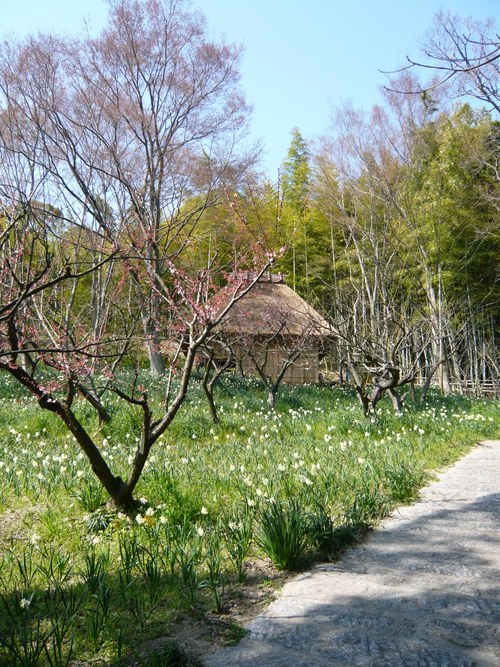
Rugged footpaths lead visitors up and around the steep slope,

allowing them to stumble upon buildings in unexpected places; such as –
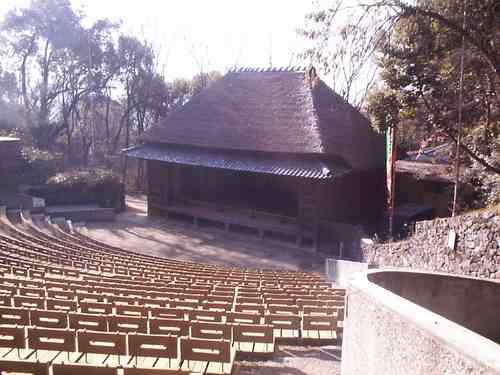
this kabuki theater,

a sugar shack,

and a papermaking hut.
The stone path up from the entrance leads to a suspension bridge which, except for the wire cable reinforcing it, is a faithful replica of those once used to cross breathtaking drops in the mountains of Shikoku's interior. (There's a way around it for the faint of heart.)
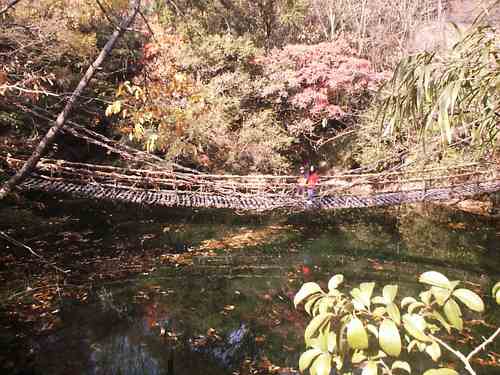
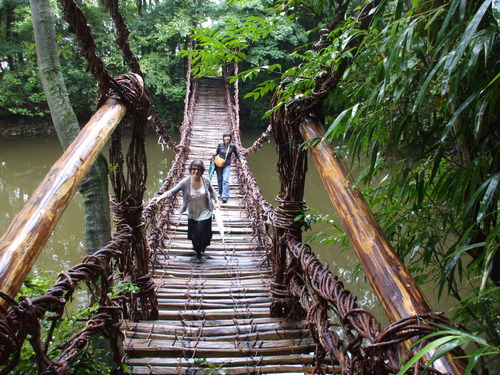
A stream meanders along another path, past mountain farmhouses and an inventor's home, and culminates in a beautiful waterfall and pond.

Waterfall in 1987
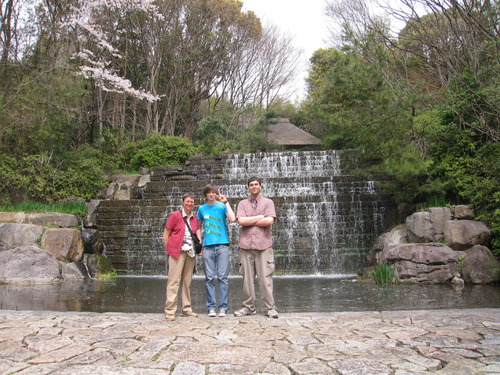
And 20 years later (with different people!)
If I remember correctly, the lotuses in this pond are an ancient species cultivated from excavated seeds. Much of the stonework, as well as the fountain and waterfall, were designed by sculptor Masayuki Nagare and built by the area's superb stonemasons. The stones were reused from such things as old building foundations.
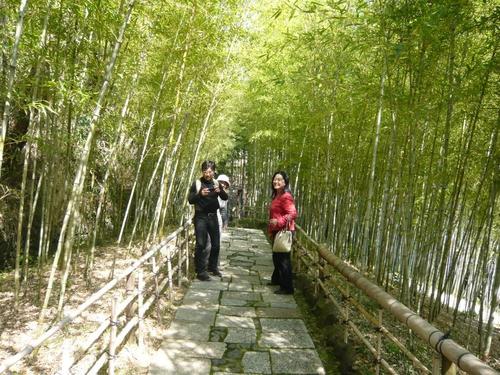
It's really a lovely hike of discovery that takes about an hour and a half or longer if you want to enjoy the flowers or examine the thousands of tools and implements. The English signs are very readable and informative, an added bonus as this is not always the case in Japan!
A visitor demonstrating his strenght with the strength-testing stones
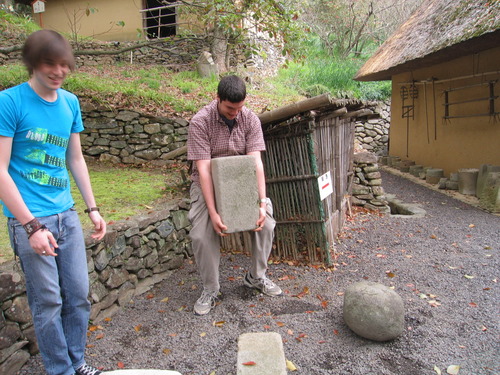
Another visitor who was less successful.
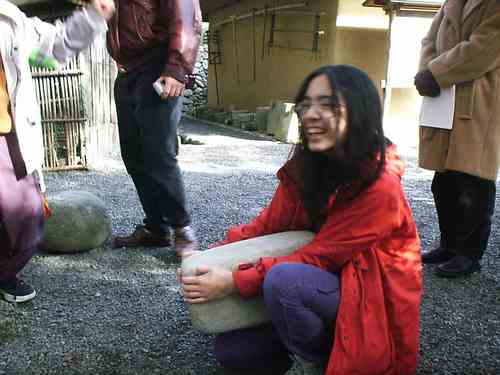
Several of the buildings such as the kabuki theater and the inventor Michitaka Kume's house are used to host educational and social events and concerts, and can also be rented by private groups.
Just outside the museum, there are two restaurants, also housed in beautiful traditional architecture: the popular udon shop, Waraya, and the European-style tearoom, Ijinkan relocated from Kobe. Both provide an excellent finishing touch to a beautiful hike. The tearoom hosts concerts so you can enjoy music with tea and cake.
Shikoku Mura is a great place to experience traditional Japanese culture and history and the influence of other cultures upon it - and all within a beautiful natural setting.
Hours and Fees
Hours: 8:30 to 17:30 (until 18:00 from April to October)
Open year round.
Admission: 800 yen for park only; 1000 yen for a combined park and art gallery ticket
Restaurants: Also open year round, 10:00-19:00 (18:30 in winter) on weekdays 9:00-19:00 on holidays/weekends for the Ijinkan and 9:30-17:30 (March 1 - Nov. 23) and 9:30-17:00 (Nov. 24-end Feb.) for Waraya.
Access:
By Kotoden: Take a train from Takamatsu-Chikko Station to Kawaramachi Station (4 min., frequent departures) and transfer to the Shido Line. Get off at Kotoden Yashima Station (13 minutes, 3 trains/hour). Total time: about 20 minutes. Cost: 310 yen. It’s a 5-minute walk from the station.
By JR: Take a local train from JR Takamatsu Station in the direction of Tokushima. Get off at Yashima Station (15 minutes, 210 yen, 2 trains/hour). It’s a 15-minute walk from the station.
Website: http://www.shikokumura.or.jp/ (Japanese only)

At the moment, there are thirty-three reconstructed buildings, some of which are several centuries old and 17 of which have been designated as important cultural properties or assets. They are nestled among trees and fields of flowers, making this museum a great nature walk as well.
Paper hut (2)
Rugged footpaths lead visitors up and around the steep slope,

allowing them to stumble upon buildings in unexpected places; such as –

this kabuki theater,

a sugar shack,

and a papermaking hut.
The stone path up from the entrance leads to a suspension bridge which, except for the wire cable reinforcing it, is a faithful replica of those once used to cross breathtaking drops in the mountains of Shikoku's interior. (There's a way around it for the faint of heart.)

A stream meanders along another path, past mountain farmhouses and an inventor's home, and culminates in a beautiful waterfall and pond.

Waterfall in 1987
And 20 years later (with different people!)
If I remember correctly, the lotuses in this pond are an ancient species cultivated from excavated seeds. Much of the stonework, as well as the fountain and waterfall, were designed by sculptor Masayuki Nagare and built by the area's superb stonemasons. The stones were reused from such things as old building foundations.
It's really a lovely hike of discovery that takes about an hour and a half or longer if you want to enjoy the flowers or examine the thousands of tools and implements. The English signs are very readable and informative, an added bonus as this is not always the case in Japan!
A visitor demonstrating his strenght with the strength-testing stones
Another visitor who was less successful.

Several of the buildings such as the kabuki theater and the inventor Michitaka Kume's house are used to host educational and social events and concerts, and can also be rented by private groups.
Just outside the museum, there are two restaurants, also housed in beautiful traditional architecture: the popular udon shop, Waraya, and the European-style tearoom, Ijinkan relocated from Kobe. Both provide an excellent finishing touch to a beautiful hike. The tearoom hosts concerts so you can enjoy music with tea and cake.
Shikoku Mura is a great place to experience traditional Japanese culture and history and the influence of other cultures upon it - and all within a beautiful natural setting.
Hours and Fees
Hours: 8:30 to 17:30 (until 18:00 from April to October)
Open year round.
Admission: 800 yen for park only; 1000 yen for a combined park and art gallery ticket
Restaurants: Also open year round, 10:00-19:00 (18:30 in winter) on weekdays 9:00-19:00 on holidays/weekends for the Ijinkan and 9:30-17:30 (March 1 - Nov. 23) and 9:30-17:00 (Nov. 24-end Feb.) for Waraya.
Access:
By Kotoden: Take a train from Takamatsu-Chikko Station to Kawaramachi Station (4 min., frequent departures) and transfer to the Shido Line. Get off at Kotoden Yashima Station (13 minutes, 3 trains/hour). Total time: about 20 minutes. Cost: 310 yen. It’s a 5-minute walk from the station.
By JR: Take a local train from JR Takamatsu Station in the direction of Tokushima. Get off at Yashima Station (15 minutes, 210 yen, 2 trains/hour). It’s a 15-minute walk from the station.
Website: http://www.shikokumura.or.jp/ (Japanese only)
Posted by cathy at
16:07
│Comments(0)



